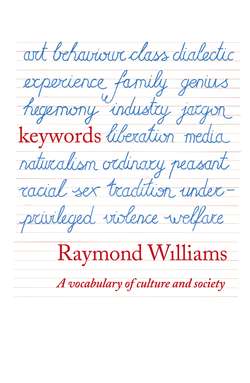Читать книгу Keywords: A Vocabulary of Culture and Society - Raymond Williams - Страница 13
ART
ОглавлениеThe original general meaning of art, to refer to any kind of skill, is still active in English. But a more specialized meaning has become common, and in the arts and to a large extent in artist has become predominant.
Art has been used in English from C13, fw art, oF, rw artem, L – skill. It was widely applied, without predominant specialization, until lC17, in matters as various as mathematics, medicine and angling. In the medieval university curriculum the arts (‘the seven arts’ and later ‘the LIBERAL (q.v.) arts’) were grammar, logic, rhetoric, arithmetic, geometry, music and astronomy, and artist, from C16, was first used in this context, though with almost contemporary developments to describe any skilled person (as which it is in effect identical with artisan until lC16) or a practitioner of one of the arts in another grouping, those presided over by the seven muses: history, poetry, comedy, tragedy, music, dancing, astronomy. Then, from lC17, there was an increasingly common specialized application to a group of skills not hitherto formally represented: painting, drawing, engraving and sculpture. The now dominant use of art and artist to refer to these skills was not fully established until lC19, but it was within this grouping that in lC18, and with special reference to the exclusion of engravers from the new Royal Academy, a now general distinction between artist and artisan – the latter being specialized to ‘skilled manual worker’ without ‘intellectual’ or ‘imaginative’ or ‘creative’ purposes – was strengthened and popularized. This development of artisan, and the mC19 definition of scientist, allowed the specialization of artist and the distinction not now of the liberal but of the fine arts.
The emergence of an abstract, capitalized Art, with its own internal but general principles, is difficult to localize. There are several plausible C18 uses, but it was in C19 that the concept became general. It is historically related, in this sense, to the development of CULTURE and AESTHETICS (qq.v.). Wordsworth wrote to the painter Haydon in 1815: ‘High is our calling, friend, Creative Art.’ The now normal association with creative and imaginative, as a matter of classification, dates effectively from lC18 and eC19. The significant adjective artistic dates effectively from mC19. Artistic temperament and artistic sensibility date from the same period. So too does artiste, a further distinguishing specialization to describe performers such as actors or singers, thus keeping artist for painter, sculptor and eventually (from mC19) writer and composer.
It is interesting to notice what words, in different periods, are ordinarily distinguished from or contrasted with art. Artless before mC17 meant ‘unskilled’ or ‘devoid of skill’, and this sense has survived. But there was an early regular contrast between art and nature: that is, between the product of human skill and the product of some inherent quality. Artless then acquired, from mC17 but especially from lC18, a positive sense to indicate spontaneity even in ‘art’. While art still meant skill and INDUSTRY (q.v.) diligent skill, they were often closely associated, but when each was abstracted and specialized they were often, from eC19, contrasted as the separate areas of imagination and utility. Until C18 most sciences were arts; the modern distinction between science and art, as contrasted areas of human skill and effort, with fundamentally different methods and purposes, dates effectively from mC19, though the words themselves are sometimes contrasted, much earlier, in the sense of ‘theory’ and ‘practice’ (see SCIENCE, THEORY).
This complex set of historical distinctions between various kinds of human skill and between varying basic purposes in the use of such skills is evidently related both to changes in the practical division of labour and to fundamental changes in practical definitions of the purposes of the exercise of skill. It can be primarily related to the changes inherent in capitalist commodity production, with its specialization and reduction of use values to exchange values. There was a consequent defensive specialization of certain skills and purposes to the arts or the humanities where forms of general use and intention which were not determined by immediate exchange could be at least conceptually abstracted. This is the formal basis of the distinction between art and industry, and between fine arts and useful arts (the latter eventually acquiring a new specialized term, in TECHNOLOGY (q.v.)).
The artist is then distinct within this fundamental perspective not only from scientist and technologist – each of whom in earlier periods would have been called artist – but from artisan and craftsman and skilled worker, who are now operatives in terms of a specific definition and organization of WORK (q.v.). As these practical distinctions are pressed, within a given mode of production, art and artist acquire ever more general (and more vague) associations, offering to express a general human (i.e. non-utilitarian) interest, even while, ironically, most works of art are effectively treated as commodities and most artists, even when they justly claim quite other intentions, are effectively treated as a category of independent craftsmen or skilled workers producing a certain kind of marginal commodity.
See AESTHETIC, CREATIVE, CULTURE, GENIUS, INDUSTRY, SCIENCE, TECHNOLOGY
